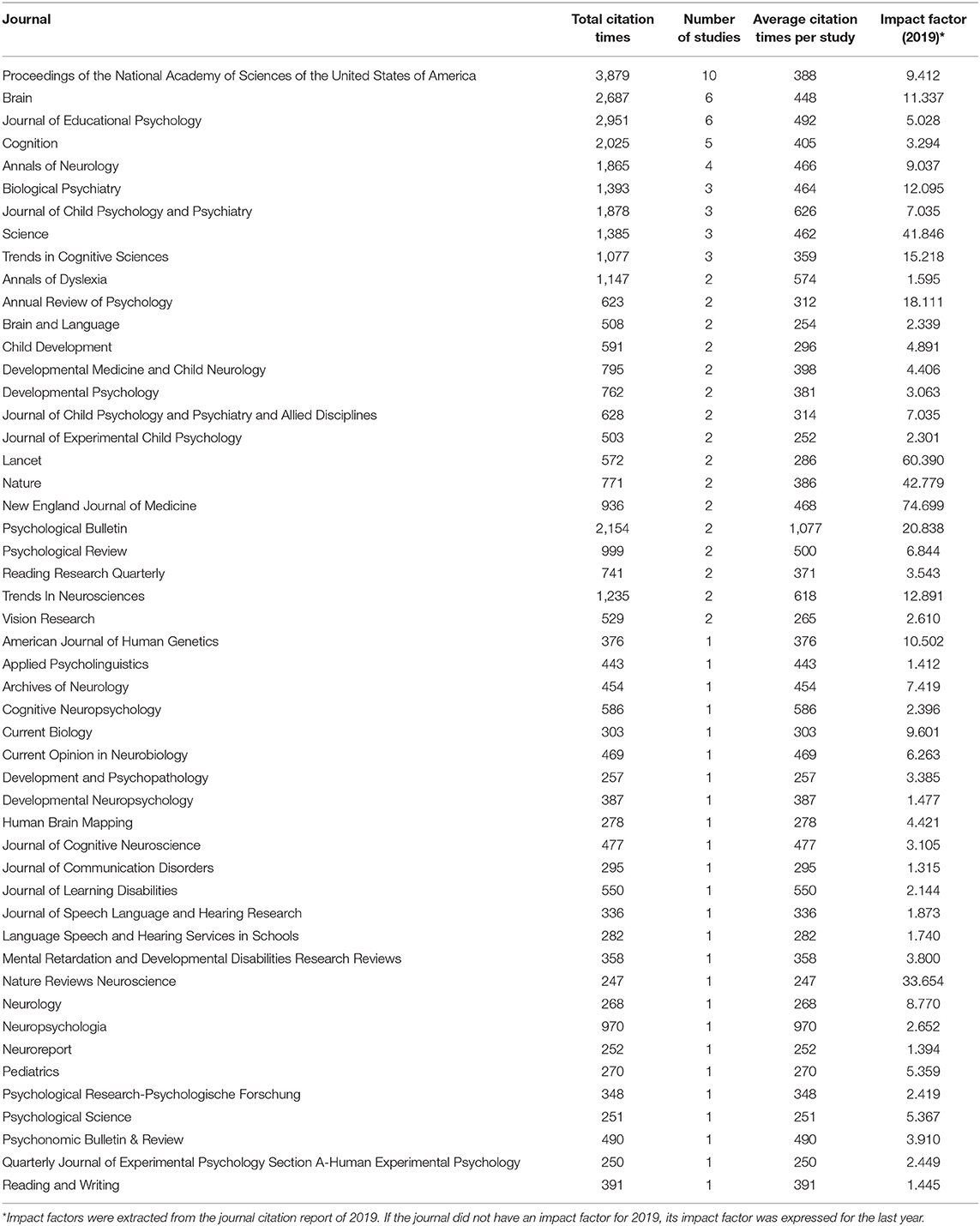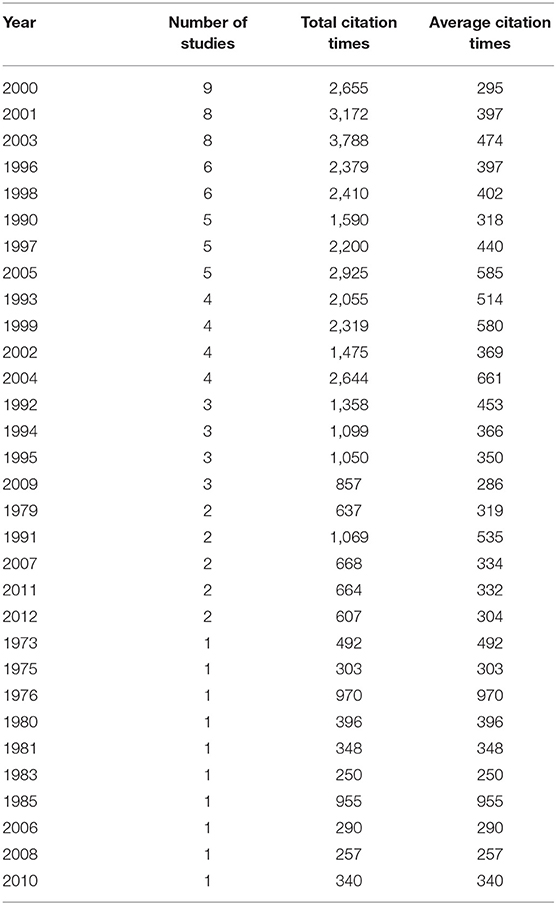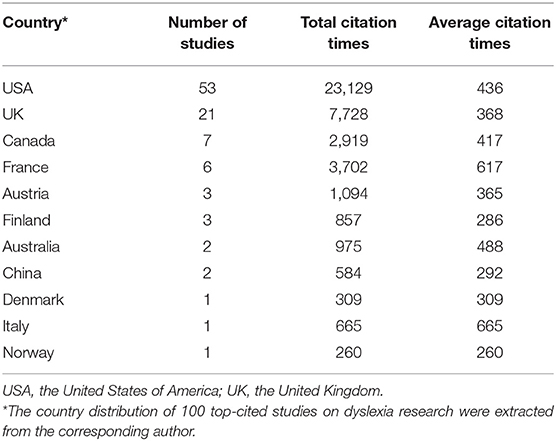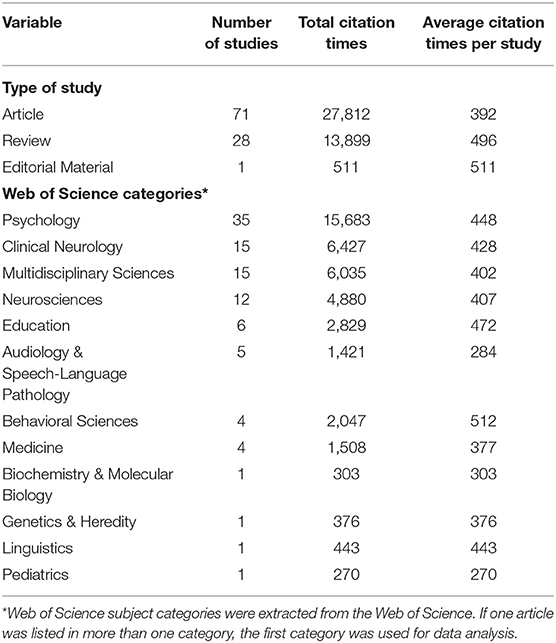- 1Department of Respiratory and Critical Care Medicine, West China Hospital/West China School of Medicine, Sichuan University, Chengdu, China
- 2Department of Periodical Press and National Clinical Research Center for Geriatrics, West China Hospital, Sichuan University, Chengdu, China
- 3Chinese Evidence-Based Medicine Center, West China Hospital, Sichuan University, Chengdu, China
Background: Citation analysis is a type of quantitative and bibliometric analytic method designed to rank papers based on their citation counts. Over the last few decades, the research on dyslexia has made some progress which helps us to assess this disease, but a citation analysis on dyslexia that reflects these advances is lacking.
Methods: A retrospective bibliometric analysis was performed using the Web of Science Core Collection database. The 100 top-cited studies on dyslexia were retrieved after reviewing abstracts or full-texts to May 20th, 2021. Data from the 100 top-cited studies were subsequently extracted and analyzed.
Results: The 100 top-cited studies on dyslexia were cited between 245 to 1,456 times, with a median citation count of 345. These studies were published in 50 different journals, with the “Proceedings of the National Academy of Sciences of the United States of America” having published the most (n = 10). The studies were published between 1973 and 2012 and the most prolific year in terms of number of publications was 2000. Eleven countries contributed to the 100 top-cited studies, and nearly 75% articles were either from the USA (n = 53) or United Kingdom (n = 21). Eighteen researchers published at least two different studies of the 100 top-cited list as the first author. Furthermore, 71 studies were published as an original research article, 28 studies were review articles, and one study was published as an editorial material. Finally, “Psychology” was the most frequent study category.
Conclusions: This analysis provides a better understanding on dyslexia and may help doctors, researchers, and stakeholders to achieve a more comprehensive understanding of classic studies, new discoveries, and trends regarding this research field, thus promoting ideas for future investigation.
Introduction
Dyslexia is a common learning disorder that affects between 4 and 8% of children (1–3), and often persists into adulthood (4, 5). This neurodevelopmental disorder is characterized by reading and spelling impairments that develop in a context of normal intelligence, educational opportunities, and perceptual abilities (4, 6). Reading and spelling abilities can be affected together or separately. The learning abilities of children with dyslexia are significantly lower than those of their unaffected pairs of the same age. Generally, difficulties begin to show during the early school years. Dyslexia is a complex multifactorial disorder whose etiology has not been fully elucidated, and it has caused great social and economic burdens. Over the last few decades, the research on dyslexia has made some progress. For example, some studies have shown that dyslexia has a strong genetic background that can affect brain anatomy (7, 8) and function (9, 10). But a citation analysis on dyslexia that reflects these advances is lacking.
The publication of study results in scientific journals is the most effective strategy to disseminate new research findings. A high number of citations can indicate the potential of a paper to influence the research community and to generate meaningful changes in clinical practice (11). Citation analysis is a type of quantitative and bibliometric analytic method designed to rank papers based on their citation counts. The latest and up-to-date research findings on dyslexia are well-reflected in recent scientific papers (12), particularly in the most cited ones (13, 14). By analyzing the most cited studies, especially the 100 top-cited studies, we can gain better insight into the most significant advances made in the field of dyslexia research over the course of the past several decades (15). This retrospective bibliometric approach has been used for many other diseases, such as diabetes (16), endodontics (17), cancer (18). However, to date, no bibliometric analyses have been conducted in the field of dyslexia. Therefore, the aim of the present study was to analyze the 100 top-cited studies in the field of dyslexia.
Materials and Methods
Search Method and Inclusion Criteria
This retrospective bibliometric analysis was conducted using the Web of Science Core Collection database. The Web of Science Core Collection is a multidisciplinary database with searchable authors and abstracts covering a vast science journal literature (19). It indexes the major journals of more than 170 subject categories, providing access to retrospective data between 1945 and the present (20). On May 20th, 2021, we conducted an exhaustive literature retrieval, regardless of the country of origin, publication year, and language. The only search term used was “dyslexia” and the search results were sorted by the number of citations.
Article Selection
Two authors independently screened the abstracts or full-texts to identify the 100 top-cited articles about dyslexia. Disagreements were resolved through discussion. Only studies that focused on dyslexia were included in subsequent analyses. Studies that only mentioned dyslexia in passing were excluded.
Data Extraction
The final list of the 100 top-cited studies on dyslexia was determined by total article citation counts. We extracted the following data for each article: title, authors, journal, language, total citation count, publication year, country, journal impact factor, type of article, and Web of Science subject category. If the reprint author had two or more affiliations from different countries, we used the first affiliation as the country of origin. If one article was listed in more than one subject category, the first category was selected. If one article had more than one author, we selected the first-ranked author as the first author and the last-ranked author as the last-author.
Data Analysis
SPSS 11.0 (Chicago, IL, USA) was used to count the frequency. We analyzed the following data: citation count, year of publication, country, the first author, journal, language, type of study, and Web of Science subject category.
Results
Citation Analysis
The 100 top-cited studies on dyslexia based on total citations are listed in Table 1. The total citation count for these 100 articles combined was 42,222. The total citation count of per study ranged from 245 to 1,456 times, with a median citation count of 345. Only 3 studies were cited more than 1,000 times, and the rest of the studies were cited between 100 and 1,000 times. The title of the top-cited study, which also had the largest mean citation per year count (n = 91), was “Reading acquisition, developmental dyslexia, and skilled reading across languages: a psycholinguistic grain size theory,” which was published by Ziegler et al. in Psychological Bulletin in 2005 (21). The second top-cited study, which also had the second-highest mean citation per year count (n = 80), was published by Vellutino et al. (22). In addition, we also identified the 100 top-cited studies on dyslexia based on mean citation per year, whose results were shown in Supplementary Table 1.
Journals
The different journals of the 100 top-cited studies on dyslexia and their associated impact factors are listed in Table 2. The 100 top-cited studies on dyslexia were published in 50 different journals, with the top three in frequency being “Proceedings of the National Academy of Sciences of the United States of America” (n = 10), “Brain” (n = 6), and “Journal of Educational Psychology” (n = 6).
The journal with the highest total citation count was “Proceedings of the National Academy of Sciences of the United States of America.” However, the highest average citation count per study belonged to the journal “Psychological Bulletin.” The journal impact factors of the 100 top-cited studies on dyslexia ranged from 1.315 to 74.699. Of the 100 top-cited studies, 29 were published in a journal with an impact factor greater than 10. The standard “CNS” journals, with the exception of “Cell,” “Nature,” and “Science” published 2 and 3 studies, respectively. Regarding the top four medical journals, while the “New England Journal of Medicine” and “Lancet” published 2 studies each, no top-cited study was published by the “Journal of the American Medical Association” or the “British Medical Journal.”
Language and Year of Publication
The 100 top-cited studies on dyslexia were all published in English and were published between 1973 [by Boder et al. (23)] and 2012 [by Norton et al. (24) and Peterson et al. (25)] (Table 3). The most productive years were 2000, 2001 and 2003, with 9, 8 and 8 published articles, respectively. The year of 2003 had the most total citations with a total count of 3,788 and an average citation count per study of 474.
Countries and Authors
Eleven countries contributed articles to the 100 top-cited studies on dyslexia (Table 4). Most of the articles were from the USA (n = 53), United Kingdom (n = 21), Canada (n = 7), and France (n = 6). In addition, the USA had the highest total citation count (23,129), and Italy had the highest average citation count per study (665).
As shown in Table 5, there were 18 first-authors and 13 last-authors who published more than one of the 100 top-cited studies on dyslexia. Among them, Shaywitz SE published the most top 100 articles (n = 7) on dyslexia as the first author, followed by Galaburda AM (n = 3) and Pugh KR (n = 3). And for the last author, 8 studies of the 100 top-cited studies on dyslexia research were published by Shaywitz BA who was the most productive.
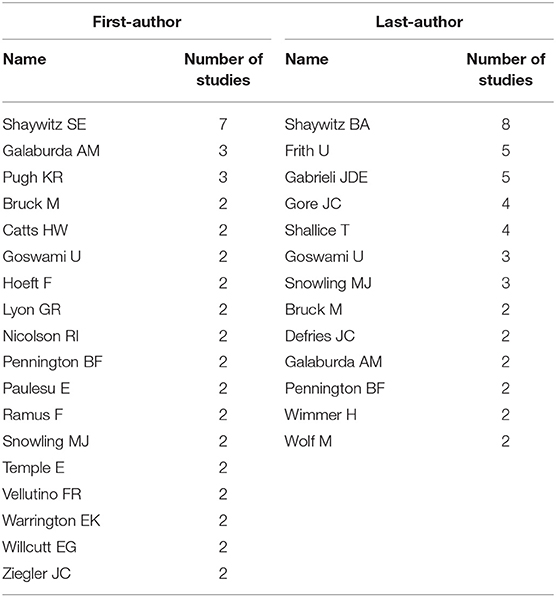
Table 5. Authors with at least two first-author or last-author publications in the 100 top-cited studies on dyslexia.
Publication Type and Web of Science Subject Categories
As shown in Table 6, there were 71 studies in the form of an original research article, 28 studies in the form of a review article, and one study in the form of an editorial material publication. The total citation counts for each publication type were 27,812, 13,899, and 511, respectively. Although the type of original research article had the highest total citation count, it had the lowest average citation count per study. In addition, a total of 12 Web of Science subject categories were extracted. Among them, “Psychology” was the most frequent category associated with studies [35], followed by “Clinical Neurology” [15], and “Multidisciplinary Sciences” [15], “Neurosciences” [12], and “Education” [6]. Consistent with the number of studies, the subject categories of “Psychology” and “Clinical Neurology” also had the highest total citation counts (15,683 and 6,427, respectively). The “Behavioral Sciences” subject category had the highest average citation count.
Discussion
Although retrospective bibliometric approach has been conducted in many other diseases, to our knowledge, no citation analyses have examined publications on dyslexia. Therefore, this study is the first comprehensive analysis summarizing several features of the most influential studies on dyslexia. It has been suggested that a highly cited study can be considered as a milestone study in a related field and has the potential to generate meaningful changes in clinical practice (26). We believe that the present analysis of the 100 top-cited studies on dyslexia may be beneficial to the research community for the following reasons. First, the present study not only provides a historical projection of the scientific progress with regards to dyslexia research, but it also shows associated research trends and gaps in the field (27). Second, our findings provide critical quantitative information about how both the classic studies and recent advancements in the field have improved our understanding of dyslexia (28). Third, the present analysis may help journal editors, funding agencies, and reviewers critically evaluate studies and funding applications (28).
Our analysis discovered that the 100 top-cited studies on dyslexia were published in 50 different journals. This may reflect the fact that the 100 top-cited studies on dyslexia were very multidisciplinary in nature, unlike the top studies of other fields (e.g., psoriatic arthritis) where there is a more inherent researcher bias for journal selection (29). Of the 100 top-cited studies, 29 were published in a journal with an impact factor >10, and 62 studies were published in journal with an impact factor >5. However, there were only five studies published in the standard “CNS” journals and only four published in the top four medical journals, which suggests that most dyslexia researchers are more inclined to choose the most influential journals in their respective professional fields when submitting articles (30). This is in marked contrast with some other fields (e.g. vaccines), where the majority of top-cited articles are published in either the standard “CNS” journals or in the top four medical journals (15). Several other factors, such as the review turnaround time, likelihood of manuscript acceptance, publication costs, journal publication frequency, will all invariably also affect a researcher's journal selection (13, 20).
According to the results of our analysis, nearly 80% of the 100 top-cited studies on dyslexia were published between 1990 and 2005, and the years of 2000 was found to have the most publications. The increase of landmark publications between 1990 and 2005 might reflect an increase in the interest in dyslexia research or that researchers had made some important scientific breakthroughs during this time period. All the top-cited studies on dyslexia were published in English, likely because English is the most commonly used language for knowledge dissemination in the world.
The top countries with regards to total citation count and number of papers in the top 100 list were the USA (n = 53) and United Kingdom (n = 21), which accounted for ~75% of the 100 top-cited studies. The USA published the most studies from the list, and this is probably because some of the world's top research centers are located in the USA and likely also the USA receives more research funding (31). Furthermore, the most prolific first-author (Shaywitz SE) and last-author (Shaywitz BA) were also from the USA. It is also worth mentioning that China had two studies on the top 100 list, which attests to the improvement of our national scientific research community with regards to knowledge dissemination.
In the present study, there were more original research articles (n = 71) than review articles (n = 28), but the latter had higher average citation counts per study. These results indicate that even though researchers pay significant attention to new findings on dyslexia, they regularly use information from review articles to convey relevant points in their own papers. We found that “Psychology” was the most frequent subject category associated with the top 100 articles, which indicates that researchers have been working to find effective treatments for people with dyslexia and that research in this field will continue to progress.
Like with other bibliometric analyses, there are some study limitations that should be highlighted. First, the 100 top-cited studies were extracted from the Web of Science Core Collection, which might have excluded some top-cited studies from other databases, such as Scopus and Google Scholar. Second, there was no citation data for recently published studies. Third, self-citations might have substantially influenced the results of the citation analysis. Moreover, this was a cross-sectional study, which implies that the identified 100 top-cited studies could change in the future. Despite these limitations, this descriptive bibliometric study could contribute new information about the scientific interest in dyslexia.
In conclusion, the present analysis is the first analysis to recognize the 100 top-cited studies in the field of dyslexia. This analysis provides a better understanding on dyslexia and may help doctors, researchers, and stakeholders to achieve a more comprehensive understanding of classic studies, new discoveries, and trends regarding this research field. As new data continue to emerge, this bibliometric analysis will become an important quantitative instrument to ascertain the overall direction of a given field, thus promoting ideas for future investigation.
Data Availability Statement
The original contributions presented in the study are included in the article/Supplementary Material, further inquiries can be directed to the corresponding author/s.
Author Contributions
YZ and HF designed the study. SZ and YZ acquired the data and performed statistical analyses. SZ, YZ, and HF drafted the manuscript. All authors critically revised the article and approved the final version of the manuscript.
Funding
This study was partly supported by National Clinical Research Center for Geriatrics, West China Hospital, Sichuan University (Z2018B016).
Conflict of Interest
The authors declare that the research was conducted in the absence of any commercial or financial relationships that could be construed as a potential conflict of interest.
Supplementary Material
The Supplementary Material for this article can be found online at: https://www.frontiersin.org/articles/10.3389/fpsyt.2021.714627/full#supplementary-material
References
1. Fortes IS Paula CS Oliveira MC Bordin IA de Jesus Mari J Rohde LA. A cross-sectional study to assess the prevalence of DSM-5 specific learning disorders in representative school samples from the second to sixth grade in Brazil. Eur Child Adolesc Psychiatry. (2016) 25:195–207. doi: 10.1007/s00787-015-0708-2
2. Landerl K, Moll K. Comorbidity of learning disorders: prevalence and familial transmission. J Child Psychol Psychiatry Allied Discipl. (2010) 51:287–94. doi: 10.1111/j.1469-7610.2009.02164.x
3. Castillo A, Gilger JW. Adult perceptions of children with dyslexia in the USA. Ann Dyslexia. (2018) 68:203–17. doi: 10.1007/s11881-018-0163-0
4. Peterson RL, Pennington BF. Developmental dyslexia. Ann Rev Clin Psychol. (2015) 11:283–307. doi: 10.1146/annurev-clinpsy-032814-112842
5. Cavalli E, Colé P, Brèthes H, Lefevre E, Lascombe S, Velay JL. E-book reading hinders aspects of long-text comprehension for adults with dyslexia. Ann Dyslexia. (2019) 69:243–59. doi: 10.1007/s11881-019-00182-w
6. Wang LC, Liu D, Xu Z. Distinct effects of visual and auditory temporal processing training on reading and reading-related abilities in Chinese children with dyslexia. Ann Dyslexia. (2019) 69:166–85. doi: 10.1007/s11881-019-00176-8
7. Skeide MA, Kraft I, Müller B, Schaadt G, Neef NE, Brauer J, et al. NRSN1 associated grey matter volume of the visual word form area reveals dyslexia before school. Brain. (2016) 139:2792–803. doi: 10.1093/brain/aww153
8. Kraft I, Schreiber J, Cafiero R, Metere R, Schaadt G, Brauer J, et al. Predicting early signs of dyslexia at a preliterate age by combining behavioral assessment with structural MRI. NeuroImage. (2016) 143:378–86. doi: 10.1016/j.neuroimage.2016.09.004
9. Neef NE, Müller B, Liebig J, Schaadt G, Grigutsch M, Gunter TC, et al. Dyslexia risk gene relates to representation of sound in the auditory brainstem. Dev Cogn Neurosci. (2017) 24:63–71. doi: 10.1016/j.dcn.2017.01.008
10. Männel C, Meyer L, Wilcke A, Boltze J, Kirsten H, Friederici AD. Working-memory endophenotype and dyslexia-associated genetic variant predict dyslexia phenotype. Cortex. (2015) 71:291–305. doi: 10.1016/j.cortex.2015.06.029
11. Perazzo MF, Otoni ALC, Costa MS, Granville-Granville AF, Paiva SM, Martins-Júnior PA. The top 100 most-cited papers in paediatric dentistry journals: a bibliometric analysis. Int J Paediatr Dentist. (2019) 29:692–711. doi: 10.1111/ipd.12563
12. Daley EM, Vamos CA, Zimet GD, Rosberger Z, Thompson EL, Merrell L. The feminization of HPV: reversing gender biases in US human papillomavirus vaccine policy. Am J Public Health. (2016) 106:983–4. doi: 10.2105/AJPH.2016.303122
13. Kolkailah AA, Fugar S, Vondee N, Hirji SA, Okoh AK, Ayoub A, et al. Bibliometric analysis of the top 100 most cited articles in the first 50 years of heart transplantation. Am J Cardiol. (2019) 123:175–86. doi: 10.1016/j.amjcard.2018.09.010
14. Zhao X, Guo L, Lin Y, Wang H, Gu C, Zhao L, et al. The top 100 most cited scientific reports focused on diabetes research. Acta Diabetol. (2016) 53:13–26. doi: 10.1007/s00592-015-0813-1
15. Zhang Y, Quan L, Xiao B, Du L. The 100 top-cited studies on vaccine: a bibliometric analysis. Hum Vacc Immunother. (2019) 15:3024–31. doi: 10.1080/21645515.2019.1614398
16. Beshyah WS, Beshyah SA. Bibliometric analysis of the literature on Ramadan fasting and diabetes in the past three decades (1989-2018). Diabetes Res Clin Pract. (2019) 151:313–22. doi: 10.1016/j.diabres.2019.03.023
17. Adnan S, Ullah R. Top-cited articles in regenerative endodontics: a bibliometric analysis. J Endodontics. (2018) 44:1650–64. doi: 10.1016/j.joen.2018.07.015
18. Gao Y, Shi S, Ma W, Chen J, Cai Y, Ge L, et al. Bibliometric analysis of global research on PD-1 and PD-L1 in the field of cancer. Int Immunopharmacol. (2019) 72:374–84. doi: 10.1016/j.intimp.2019.03.045
19. Yu T, Jiang Y, Gamber M, Ali G, Xu T, Sun W. Socioeconomic status and self-rated health in China: findings from a cross-sectional study. Medicine. (2019) 98:e14904. doi: 10.1097/MD.0000000000014904
20. Yoon DY, Yun EJ, Ku YJ, Baek S, Lim KJ, Seo YL, et al. Citation classics in radiology journals: the 100 top-cited articles, 1945-2012. AJR Am J Roentgenol. (2013) 201:471–81. doi: 10.2214/AJR.12.10489
21. Ziegler JC, Goswami U. Reading acquisition, developmental dyslexia, and skilled reading across languages: a psycholinguistic grain size theory. Psychol Bull. (2005) 131:3–29. doi: 10.1037/0033-2909.131.1.3
22. Vellutino FR, Fletcher JM, Snowling MJ, Scanlon DM. Specific reading disability (dyslexia): what have we learned in the past four decades? J Child Psychol Psychiatry Allied Discipl. (2004) 45:2–40. doi: 10.1046/j.0021-9630.2003.00305.x
23. Boder E. Developmental dyslexia: a diagnostic approach based on three atypical reading-spelling patterns. Dev Med Child Neurol. (1973) 15:663–87. doi: 10.1111/j.1469-8749.1973.tb05180.x
24. Norton ES, Wolf M. Rapid automatized naming (RAN) and reading fluency: implications for understanding and treatment of reading disabilities. Ann Rev Psychol. (2012) 63:427–52. doi: 10.1146/annurev-psych-120710-100431
25. Peterson RL, Pennington BF. Developmental dyslexia. Lancet. (2012) 379:1997–2007. doi: 10.1016/S0140-6736(12)60198-6
26. Van Noorden R, Maher B, Nuzzo R. The top 100 papers. Nature. (2014) 514:550–3. doi: 10.1038/514550a
27. Fardi A, Kodonas K, Gogos C, Economides N. Top-cited articles in endodontic journals. J Endodontics. (2011) 37:1183–90. doi: 10.1016/j.joen.2011.05.037
28. Gondivkar SM, Sarode SC, Gadbail AR, Gondivkar RS, Choudhary N, Patil S. Citation classics in cone beam computed tomography: the 100 top-cited articles. Int J Dentistry. (2018) 2018:9423281. doi: 10.1155/2018/9423281
29. Berlinberg A, Bilal J, Riaz IB, Kurtzman DJB. The 100 top-cited publications in psoriatic arthritis: a bibliometric analysis. Int J Dermatol. (2019) 58:1023–34. doi: 10.1111/ijd.14261
30. Bullock N, Ellul T, Bennett A, Steggall M, Brown G. The 100 most influential manuscripts in andrology: a bibliometric analysis. Basic Clin Androl. (2018) 28:15. doi: 10.1186/s12610-018-0080-4
Keywords: dyslexia, bibliometric analysis, top-cited, citation analysis, citation
Citation: Zhang S, Fan H and Zhang Y (2021) The 100 Top-Cited Studies on Dyslexia Research: A Bibliometric Analysis. Front. Psychiatry 12:714627. doi: 10.3389/fpsyt.2021.714627
Received: 25 May 2021; Accepted: 28 June 2021;
Published: 22 July 2021.
Edited by:
David Cohen, Université Pierre et Marie Curie, FranceReviewed by:
Michel Habib, Aix-Marseille Université, FranceJohannes Boltze, University of Warwick, United Kingdom
Copyright © 2021 Zhang, Fan and Zhang. This is an open-access article distributed under the terms of the Creative Commons Attribution License (CC BY). The use, distribution or reproduction in other forums is permitted, provided the original author(s) and the copyright owner(s) are credited and that the original publication in this journal is cited, in accordance with accepted academic practice. No use, distribution or reproduction is permitted which does not comply with these terms.
*Correspondence: Hong Fan, ZmFuaG9uZ2ZhbkBxcS5jb20=; Yonggang Zhang, amVibV96aGFuZ0B5YWhvby5jb20=
 Shijie Zhang
Shijie Zhang Hong Fan
Hong Fan Yonggang Zhang
Yonggang Zhang
